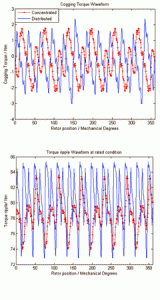Windings for Surface-Mount PM Machines
Y. Duan, R. G. Harley and T. G. Habetler Georgia Institute of Technology, Atlanta, GA
The use of both surface-mounted and interior-mounted magnet types of permanent magnet (PM) machines has grown significantly and there is a need for machines with higher efficiencies and larger power densities. The concept of concentrated stator windings (instead of the more traditional distributed windings) has been proposed for surface-mounted PM motors due to the advantages of lower manufacturing cost, ease of winding, increase in the slot fill factor, and shorter end windings. However, the concentrated winding type machines could have larger cogging torque and produce more harmonics in the output torque than a distributed winding machine. Moreover, whether traditional techniques for distributed winding machine design can be directly applied to the design of concentrated windings is not fully understood.
This work proposes a systematic design method for both distributed and concentrated winding types of surface-mounted PM motors with optimization. The design process was divided into two steps. (1) Rotor design, which included the selection of permanent magnet material, the determination of magnet thickness, pole coverage coefficient and magnetization. The rotor design produced a proper airgap flux density waveform and kept cogging and ripple torques within defined limits. (2) Sizing and stator design. An analytical model was developed to predict the motor performance, and Particle Swarm Optimization was applied to find the optimized geometry parameters. From the proposed design method, an optimized design of distributed and concentrated winding type machines can be generated.
Both concentrated and distributed winding type PM machines were designed by Maxwell 2D simulation and compared in regard to weight, volume and harmonics. The concentrated stator winding machine showed a distinct advantage in terms of weight, cogging torque and ripple torque. These torques could probably be further reduced for both machines with multiple optimization studies. Cogging torque and ripple torque of the two prototypes are illustrated in Figure 3.
The following paper will be presented in September 2008: Y. Duan, R. G. Harley, and T. G. Habetler, “Multi-objective Design Optimization of Surface Mount Permanent Magnet Machine with Particle Swarm Intelligence,”
IEEE Swarm Intelligence Symposium, St. Louis, Sep. 2008.
This work is supported by the Grainger Center for Electric Machinery and Electromechanics.
